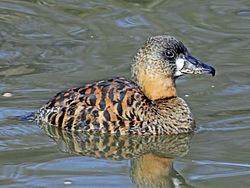| White-backed duck | |
|---|---|
 | |
| Scientific classification | |
| Kingdom: | Animalia |
| Phylum: | Chordata |
| Class: | Aves |
| Order: | Anseriformes |
| Family: | Anatidae |
| Subfamily: | Dendrocygninae Livezey, 1986 |
| Genus: | Thalassornis Eyton, 1838 |
| Species: | T. leuconotus |
| Binomial name | |
| Thalassornis leuconotus Eyton, 1838 | |
| Subspecies | |
| |
The white-backed duck (Thalassornis leuconotus) is a waterbird of the family Anatidae. It is distinct from all other ducks, but most closely related to the whistling ducks in the subfamily Dendrocygninae, though also showing some similarities to the stiff-tailed ducks in the subfamily Oxyurinae. It is the only member of the genus Thalassornis.







